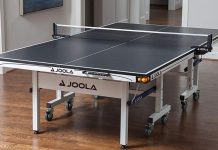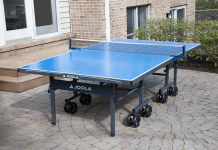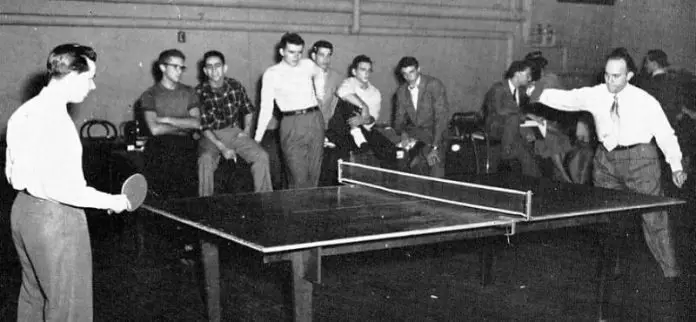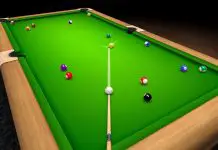A common question that usually arises among ping pong lovers is, “where did Ping-Pong originate?” At about the second half of the 19th century, Ping pong started to be born in England through university students and also by English military personnel.
Play in an improvised way; the nets were usually represented with the books that the students studied. On the other hand, the racket was made of cardboard or animal casing used by the military in the war. It was a game that they used to pass the time. Also, they did not depend on the weather to practice tennis, the sport from which table tennis originated.
Table of Contents
Who Invented Ping Pong?
When the question of “who invented ping pong” appears, many names usually pop up. In 1880, wealthy Victorians were the first (unofficial) inventors of ping pong. Afterward, the J.H. singer named the sports table tennis. Also, David Foster officially launched the sport in 1890. At the same time, John Jacque & Son came with a new name, the “Gossima”.
Advances and New Materials
In 1901, James Gibb, an English enthusiast of the game of ping pong, on a trip to the USA discovered celluloid balls and immediately understood that they could be the ideal complement to play ping pong. It was here the name of ping pong arose from due to the characteristic noise that the ball produced when it bounced on the board. British engineer James Gibb thus gave it the name we know today.
Likewise in 1901, another significant advancement was made for the modern version of this sport: EC Goode invented the modern style of the ping pong racket using a granulated rubber sheet.
The first paddles were usually wrapped with sandpaper that gave each stroke a distinctive sound. In the 1950s, rackets that were made of a rubber sheet combined with a sponge layer changed the game dramatically, introducing more excellent spin and speed. These were introduced to Britain by sporting goods manufacturer SW Hancock Ltd.
Over the years, ping pong quickly became more fashionable. Many championships with extensive participation also began to take place.
In 1921, the Table Tennis Association was established in England, with 500 players and 39 clubs. In 1926 the ITTF, the International Table Tennis Federation, was created, which has been the governing body of the game ever since then.
Ping-Pong “turns” Table Tennis
In 1922, in England, through JJ Payne, from the city of Luton, Percival Bromfield, from the city of Beckenham, F. Carris, from the city of Manchester and other veterans, formed a Ping-Pong Association. However, they were legally barred from using this name (Ping-Pong) because it was already registered as a trademark by Parker Bros.
It was on the same day of this attempt to create the Association that they decided to call the sport by another name, Table Tennis.
Taking all precautions, Payne and company, carefully drafted a code of the game’s rules so that they would be accepted nationally by all supporters. They also stimulated the creation and sales of first-rate equipment. The doubles game system was also adopted at this time, in the city of Manchester, England. And four years later, the rules were accepted abroad. Shortly afterward, the sport was already practiced in simple forms as well. Shortly afterward, the code of rules ended up becoming the basis for international rules, and the name ‘Table Tennis’ became official as well.
In 1926, the ITTF (International Table Tennis Federation) was created in Berlin, Germany, an entity that is still responsible for the sport until today.

The Professionalism of Table Tennis and the Main Athletes
Many countries tried table tennis before it became a professional sport. Japan, China, Korea, and Hong Kong, practiced the sport before 1920.
With the inception of the International Table Tennis Federation in 1926, the sport would undergo some modifications based on the code of rules launched by Payne and the Table Tennis Association. An example of these modifications was the establishment of time rules, making the game faster, and requiring greater attack strength.
The same year that the ITTF was created, the First World Table Tennis Championship was held in London, England.
In 1952, the World Tennis Cup was already in its nineteenth edition (since it was practiced annually) and marked the first competition in the Asian world, held in Bobaim, India. In 1953, China made its debut in world competitions.
From 1957, the World Championships started to happen every two years. In 1977, the ITTF received the recognition of Table Tennis as a sport from the IOC (International Olympic Committee).
In 1988, eleven years after being recognized by the IOC, Table Tennis entered the Seoul Olympic Games in South Korea from where it never left.
Since the debut of Table Tennis at the Olympic Games, the sport has continued to grow around the world. Currently, the International Table Tennis Federation has more than 124 affiliated Associations worldwide.
Today, China stands as the country with the most significant tradition in the sport since the 1980s. And among the big names that appear are tennis player Wang Nan, considered the best of all time with four Olympic gold medals, tennis player Wang Hao and another Chinese tennis player, Zhang Yining.

Regulatory Evolution
The regulation of table tennis has been undergoing evolution since its origins. At the 1936 World Championship in Prague, the game system was found to make points last a long time, and some matches took hours to complete.
In the beginning, 21-point games were played. This involved the best among three games for doubles and the best among five games for individual matches. The style of play and the materials of the time favoured the defensive game. It was a significant reason why the games were quite lengthy and were not quite as attractive as that they should.
The 1950s completely changed the game with the invention of the rubber sponge or sandwich, a new material for ping pong bats that until now had been used with a rubberized rubber overlay.
The sponge and rubber sandwich’s thickness was regulated and remains so up until today. However, the nature of the game has since been changed, establishing the fast attack speed and spin style of the modern game. Effects, topspin, cut, and many more hits as well made the game much more attractive and dynamic.
To prevent the points from lengthening, in 1948, the acceleration rule was introduced for international competitions. After the Sydney Olympics in 2000, the ITTF made the regulation to adapt it to modern times. As well as make it more visible on television. Until then, it was played with 38mm diameter balls. These were then increased to 40mm, gaining more visibility and, above all. Increasing air resistance and, therefore, making the game a little slower.
The length of the games was also varied, going from 21 points to 11. Until then, the change of service was towards every 5 points. The ITTF reduced it to two so that the games were won in both rhythm and emotion.
Ping pong at the Olympics
Ping pong was declared an Olympic sport quite recently. Its first appearance occurred at the Seoul Olympics in 1988. Previously, it was an exhibition sport at the Los Angeles Olympics in 1984.
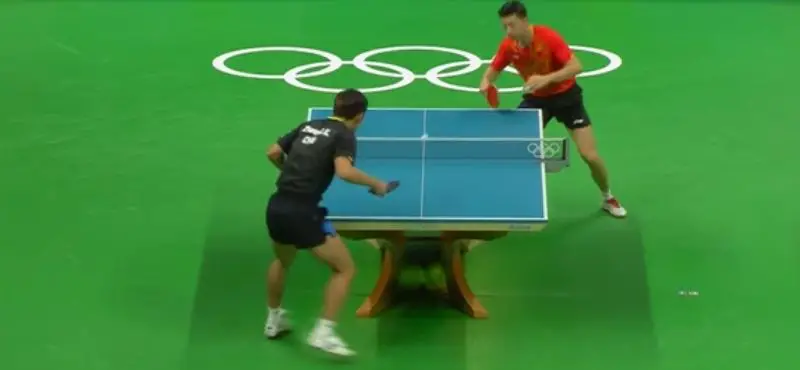
Ping Pong Regulations
The rules of table tennis have evolved over the years, but they are still relatively simple. Games are now played at 11 points instead of 21. The winner must win by at least two points. The ball is brought into play by throwing it. At least 10 inches in the air with an open hand and hitting it on the server-side of the table before it bounces past the net, next to the opponent. The receiver returns the ball (hopefully) to the server-side of the table. The ball must as well move over the net to the other side of the table and land on the opponent’s playing surface.
The official measurements or dimensions of the ping pong table (in centimetres):
- Length: 274
- Width: 152.5
- Height: 76
Furthermore, it is not correct to scream in the middle of a point or to distract your opponent by making strange gestures or noises. The surface of your racket must meet ITTF standards, but it can be the size you want as well. For example, you can use a palette the size of a dustbin lid as long as your surface complies with laid down regulations. According to ITTF standards, at least 85% of the thickness of the racket must be made of natural wood.
A point is usually scored once a player is unable to return a ball to the opponent’s playing surface. I.E. hitting the net or not hitting the opponent’s side of the table. The winner of a game must win by at least two points, as earlier elaborated. Thus, when the game reaches 11-11, play continues until a player gains a two-point lead and wins the game.
Conclusion
In conclusion, table tennis is a leisure activity and Olympic sport which is also known as “ping pong. “ Although excluded from official terminology, this name is trendy today.
Furthermore, for all lovers of this sport. The highlight of the history of ping pong above would be quite educational and worthwhile to read.

Mark is a Bloomberg BusinessWeek-based digital entrepreneur, blogger, and table tennis enthusiast. He is a former professional table tennis player with the career-best USATT ranking of 2689. He is also an ITTF Level 3 certified coach and conducts weekend coaching programs in and around the New York area. Mark is also a pool player by passion. He was first introduced to the game of pool at a very early age by his granddad. He had a natural knack for the game and quickly learned the ropes, and by the time he was 15, he was already participating in local leagues. He aims to make it into the APA league someday! Mark started his own blog by starting Indoor Games Zone, where he loves to share his years of experience with the audience. He covers ping pong, pool, air hockey, shuffleboard, and foosball.
- Ping pong
- Pool
- Air Hockey
- Shuffleboard
- Foosball

![Stiga XTR Pro Review | 1,559+ Global Ratings (In-Depth Guide) [year] Stiga XTR Pro Review](https://indoorgameszone.com/wp-content/uploads/2021/08/Stiga-XTR-Pro-Review-218x150.jpg)

